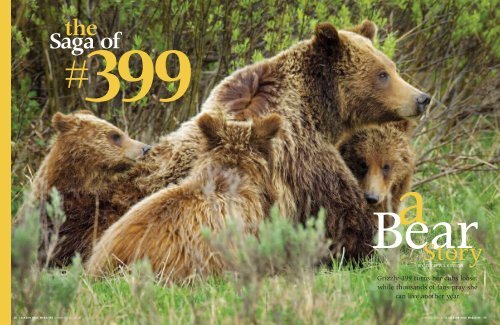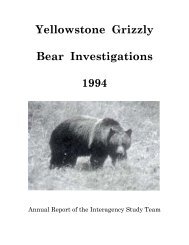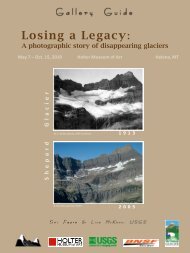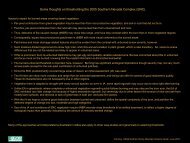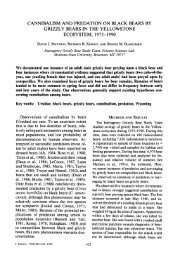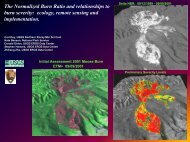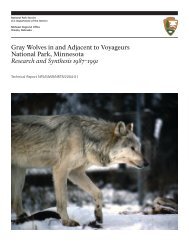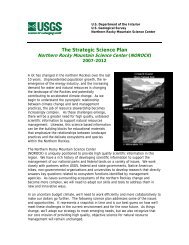The Saga of Bear #399 - Northern Rocky Mountain Science Center ...
The Saga of Bear #399 - Northern Rocky Mountain Science Center ...
The Saga of Bear #399 - Northern Rocky Mountain Science Center ...
You also want an ePaper? Increase the reach of your titles
YUMPU automatically turns print PDFs into web optimized ePapers that Google loves.
the<br />
<strong>Saga</strong> <strong>of</strong><br />
# 399<br />
a<br />
<strong>Bear</strong><br />
Story<br />
BY TODD WILKINSON<br />
THOMAS D. MANGELSEN<br />
Grizzly 399 turns her cubs loose,<br />
while thousands <strong>of</strong> fans pray she<br />
can live another year<br />
38 JACKSON HOLE MAGAZINE SUMMER/FALL 2008<br />
SUMMER/FALL 2008 JACKSON HOLE MAGAZINE<br />
39
For our species, it is one <strong>of</strong> the<br />
most sorrowful laments: the<br />
moment when parents bid<br />
their <strong>of</strong>fspring adieu to find<br />
their own way in the big, cruel world.<br />
This summer, a bear family in<br />
Jackson Hole is undergoing the ursine<br />
equivalent <strong>of</strong> that detachment. Tens <strong>of</strong><br />
thousands <strong>of</strong> humans who caught<br />
enchanting glimpses <strong>of</strong> four grizzlies in<br />
Grand Teton National Park are anxiously<br />
awaiting reports <strong>of</strong> the outcome, hoping<br />
the course <strong>of</strong> apparent inevitability<br />
can be altered.<br />
Perhaps with a Disneyesque nudge<br />
<strong>of</strong> her paw, or a gentle wo<strong>of</strong> <strong>of</strong> maternal<br />
tough love, or, more likely, a simple sidelong<br />
glance <strong>of</strong> biological indifference, a<br />
grizzly sow will peel away from her<br />
brood <strong>of</strong> triplet cubs somewhere near<br />
the shores <strong>of</strong> Jackson Lake, turning them<br />
loose to fend for themselves.<br />
But this is not the story <strong>of</strong> just any<br />
bear. <strong>Bear</strong> 399 and her tribe are part <strong>of</strong><br />
the parable <strong>of</strong> modern wildlife conservation,<br />
testing human tolerance and the<br />
willingness <strong>of</strong> people to modify their<br />
behavior in order for grizzlies to persist<br />
in the American West without the armor<br />
<strong>of</strong> federal protection.<br />
Today, there are said to be<br />
hundreds <strong>of</strong> grizzlies<br />
roaming the forests and<br />
mountains <strong>of</strong> northwest<br />
Wyoming. <strong>The</strong>se seldom-seen bears<br />
live anonymously. <strong>The</strong>ir very existence<br />
is debated, save for rare unexpected<br />
encounters with people in the woods.<br />
<strong>The</strong>n they vanish again.<br />
“For a few years now, it has been<br />
difficult for me and my colleagues to<br />
convince park staff and local people in<br />
the community that grizzlies were<br />
here in such large numbers,” says<br />
Grand Teton’s senior wildlife biologist<br />
Steve Cain. “Nobody seems to doubt it<br />
any more.”<br />
Unlike wolf packs, which are<br />
bestowed with endearing monikers,<br />
bears, when captured by researchers and<br />
outfitted with tracking beacons, assume<br />
numeric references.<br />
<strong>Bear</strong> 399 was born to a mother who<br />
had no history with the legendary<br />
Yellowstone Grizzly <strong>Bear</strong> Study Team<br />
that tracks bears across the landscape.<br />
399 gained her identity in 2001 when, as<br />
a five-year-old sow, she was caught in a<br />
research trap and fitted with a special<br />
collar that emitted signals.<br />
During the summer <strong>of</strong> 2004, 399<br />
had a single cub at her side, but the<br />
youngster disappeared, possibly from<br />
starvation or a deadly encounter with<br />
an adult male bear. Whatever the cause<br />
<strong>of</strong> the loss, events since have shown<br />
that far from being a deficient parent,<br />
399 is remarkably attentive, passing on<br />
the instincts <strong>of</strong> survival taught by her<br />
mother and necessary to survive in a<br />
crowded human world.<br />
After shedding her collar in May<br />
2005 and going <strong>of</strong>f the air, 399 was captured<br />
and collared again. In late<br />
November <strong>of</strong> that year, she crawled into<br />
her den in the northern hinters <strong>of</strong><br />
Jackson Hole for a long slumber. Around<br />
the third week <strong>of</strong> March the following<br />
spring, she emerged with three cubs the<br />
size <strong>of</strong> housecats at her side. <strong>The</strong><br />
roadsides and natural areas encompassing<br />
Jackson Lake would be their highpr<strong>of</strong>ile<br />
home.<br />
Almost immediately, the four-hundred-pound<br />
mother and cubs drew large<br />
crowds. <strong>The</strong>y became a sensation, unlike<br />
any Jackson Hole grizzly in modern<br />
memory. “I don’t like to anthropomorphize,<br />
but bears like her don’t come<br />
around very <strong>of</strong>ten,” says Franz<br />
Camenzind, executive director <strong>of</strong> the<br />
Jackson Hole Conservation Alliance. A<br />
former wildlife documentary cinematographer<br />
for television, Camenzind says<br />
that the bears’ popularity could actually<br />
prove to be their undoing, akin to<br />
celebrities hounded by paparazzi. “399<br />
represents Jackson Hole’s wildlife mascot.<br />
But I’ll be honest with you—I don’t<br />
know how the cubs will survive this year<br />
having been so habituated to people,<br />
because <strong>of</strong> the way their mother very<br />
skillfully made her living.”<br />
On April 30, 2007, an<br />
unprecedented milestone<br />
in American conservation<br />
history was reached,<br />
though it went largely unnoticed by the<br />
general public. Grizzly bears, the animal<br />
totem <strong>of</strong> the Yellowstone ecosystem and<br />
classified as a threatened species under<br />
Hundreds <strong>of</strong> grizzlies are thought to<br />
be roaming the forests and mountains<br />
<strong>of</strong> northwest Wyoming, most <strong>of</strong><br />
them rarely seen. <strong>Bear</strong> 399 and her<br />
three cubs are among the exceptions.<br />
the federal Endangered Species Act<br />
(ESA) since 1975, were removed from<br />
the protected list. <strong>The</strong>ir management<br />
was turned over to the states <strong>of</strong><br />
Wyoming, Montana, and Idaho.<br />
<strong>The</strong> momentous move attracted a<br />
swift rebuke from environmentalists<br />
who filed suit in federal court to stop it<br />
retroactively.<br />
Three decades ago when Yellowstone<br />
grizzlies received emergency protection,<br />
the population was in a free fall. Some<br />
predicted that the species here would<br />
vanish in this, the twenty-first century.<br />
Perhaps two hundred bears, and possibly<br />
far fewer, endured in the center <strong>of</strong> the<br />
ecosystem, primarily the backcountry <strong>of</strong><br />
Yellowstone National Park, after years <strong>of</strong><br />
CAL McKITRICK<br />
40 JACKSON HOLE MAGAZINE SUMMER/FALL 2008<br />
SUMMER/FALL 2008 JACKSON HOLE MAGAZINE<br />
41
lethal run-ins with humans, habitat<br />
destruction, and killing <strong>of</strong> bears done to<br />
protect domestic livestock.<br />
Following a thirty-year overhaul <strong>of</strong><br />
the way public lands are managed, grizzlies<br />
have rebounded. <strong>The</strong> most optimistic<br />
<strong>of</strong> estimates say there may be<br />
three times more grizzlies than when the<br />
population was rushed into triage.<br />
As Chuck Schwartz, leader <strong>of</strong> the<br />
Yellowstone Grizzly <strong>Bear</strong> Study Team,<br />
likes to point out, the morning after<br />
delisting occurred, logging companies, oil<br />
and gas drillers, hard-rock miners, highway<br />
engineers, and real-estate developers<br />
did not launch an immediate incursion <strong>of</strong><br />
bulldozers into prime grizzly habitat.<br />
“Little on the ground changed,” he says.<br />
“It was kind <strong>of</strong> anticlimactic.”<br />
Because <strong>of</strong> a document called the<br />
“Yellowstone Grizzly <strong>Bear</strong> Conservation<br />
Strategy”—agreed to by the states before<br />
the U.S. Fish and Wildlife Service relinquished<br />
authority—several thousand<br />
square miles <strong>of</strong> national park and forest<br />
are mandated to carry out management<br />
policies that make grizzly survival a priority.<br />
If they are not enforced, and bear<br />
numbers fall below a certain threshold,<br />
the population can be relisted. Part <strong>of</strong><br />
the special bear conservation zone<br />
extends into Grand Teton National Park<br />
and both the Bridger-Teton and<br />
Caribou-Targhee national forests.<br />
Despite claims by politicians that<br />
animals protected under the ESA served<br />
as roadblocks to economic development,<br />
delisting is more <strong>of</strong> a symbolic states’<br />
rights issue. Still, though Wyoming does<br />
plan to authorize a sport hunt <strong>of</strong> grizzlies,<br />
there are concerns about how<br />
much tolerance will be afforded wandering<br />
bears outside the conservation area.<br />
“Recovery is a transition, not a<br />
precipice,” says Dr. Christopher Servheen,<br />
the Fish and Wildlife Service’s lead grizzly-bear<br />
expert, who has spearheaded<br />
bear conservation in the Lower 48.<br />
“<strong>The</strong> fact that most people do not<br />
know that the bear is delisted, or notice<br />
it, is evidence <strong>of</strong> the success <strong>of</strong> the management<br />
system we built to assure the<br />
future <strong>of</strong> these bears,” Servheen says. “We<br />
want the bears to continue to reoccupy<br />
places where they can live, like the Tetons.<br />
This expansion is likely to continue.”<br />
Servheen and Schwartz are members <strong>of</strong><br />
399’s fan club, but they remind us she is<br />
merely a piece <strong>of</strong> the overall bear puzzle.<br />
“<strong>Bear</strong> jams” occurred frequently in Grand<br />
Teton National Park as grizzly 399 and<br />
her trio <strong>of</strong> cubs made their way around.<br />
In the months following their<br />
second birthday inside a den,<br />
grizzly cubs are cut loose by<br />
mama. Young sows may hang<br />
around their mother for another year,<br />
sharing her home range and eventually<br />
becoming her replacement in the<br />
circle <strong>of</strong> life; boars, however, strike out<br />
to establish their own territory. With<br />
the best habitat niches taken by older,<br />
more aggressive grizzlies, young males<br />
generally wind up at the outskirts <strong>of</strong><br />
established bear range or in areas that<br />
are not ideal, such as human developments.<br />
It can be a harsh, knockaround<br />
life.<br />
“Data shows that if we can keep<br />
young sub-adult bears, especially males,<br />
out <strong>of</strong> trouble for a couple <strong>of</strong> years after<br />
they leave their mother’s company, their<br />
chance <strong>of</strong> survival goes back up to the<br />
level <strong>of</strong> any wild bear in the population,”<br />
Schwartz says. “But if they get into trouble,<br />
like, say, getting into garbage or a<br />
tourist throwing them food, the probability<br />
<strong>of</strong> their survival is reduced twenty<br />
percent each year.”<br />
Schwartz further notes: “A bear that<br />
wanders beyond the national parks has a<br />
60 to 70 percent survival rate compared to<br />
an animal that stays inside Yellowstone all<br />
the time. Some <strong>of</strong> that has to do with an<br />
increased risk <strong>of</strong> coming into conflict<br />
with an armed hunter in the fall<br />
and dying as a consequence.”<br />
Adds Servheen: “<strong>Bear</strong>s cannot<br />
live without people’s help. This is<br />
especially important as bears live in<br />
risky places, as 399 does. Such bears<br />
require more care both from the public<br />
and from the Grand Teton National<br />
Park staff.”<br />
Speculation is that 399 may be frequenting<br />
roadsides and the fringes <strong>of</strong><br />
developments because large aggressive<br />
male grizzlies prefer to avoid people<br />
and dominate the terrain where few<br />
humans are.<br />
One year <strong>of</strong> <strong>Bear</strong> 399’s movements around<br />
Grand Teton National Park and the adjacent<br />
Bridger-Teton National Forest, as<br />
recorded by a GPS radio collar logging her<br />
position every 140 minutes.<br />
At Willow Flats, 399 dug for pocket<br />
gophers and excavated gopher stores <strong>of</strong><br />
wild onion; she and her cubs also ate<br />
plants like dandelion and clover. It’s the<br />
salad bar that precedes the arrival <strong>of</strong> early<br />
summer’s main course—newly born elk<br />
calves. Once the feast <strong>of</strong> meat decreases<br />
from the banquet table, as surviving calves<br />
HENRY H. HOLDSWORTH<br />
42 JACKSON HOLE MAGAZINE SUMMER/FALL 2008<br />
SUMMER/FALL 2008 JACKSON HOLE MAGAZINE 43
ecome harder to catch, bears return to<br />
yampa and Indian potato. By late summer,<br />
with seeds in whitebark pine cones now<br />
ripe, they lumber into the higher country<br />
and along the way also snack on berries.<br />
As grizzly bear numbers have<br />
grown, so, too, has the frequency <strong>of</strong> bears<br />
converging upon another food prior to<br />
denning—gut piles left behind by elk<br />
hunters after they’ve field dressed their<br />
animals in Grand Teton National Park or<br />
the Bridger-Teton National Forest.<br />
When Cain arrived to<br />
work in Grand Teton<br />
as a biologist in 1989,<br />
sightings <strong>of</strong> grizzlies<br />
here were anomalies. Recently, he spoke<br />
with Mark Haroldson, who specializes in<br />
bear demography (bear numbers and<br />
dispersal) with the grizzly bear study<br />
team based in Bozeman, Montana. <strong>The</strong>ir<br />
best pr<strong>of</strong>essional estimate is that,<br />
astoundingly, sixty different grizzlies now<br />
use parts <strong>of</strong> Grand Teton during a typical<br />
year.<br />
“When we do research trapping in<br />
the northern end <strong>of</strong> the park, we catch<br />
more grizzlies than black bears,” he says.<br />
“Nothing like that would have happened<br />
twenty years ago. 399 makes visible to<br />
large numbers <strong>of</strong> people what is going<br />
on slightly behind the scenes in Grand<br />
Teton. <strong>Bear</strong>s like her are going to be fixtures<br />
in Jackson Hole.”<br />
Trish and Mike Lavin live squarely<br />
in the middle <strong>of</strong> the new grizzly frontier.<br />
<strong>The</strong>y’re inhabitants <strong>of</strong> the Pacific Creek<br />
community, a national forest inholding<br />
<strong>of</strong> around twenty-five homes just northeast<br />
<strong>of</strong> Grand Teton’s Colter Bay Village.<br />
Both Wyoming natives (Trish is<br />
from Laramie and Mike from Casper),<br />
they have a strong family connection to<br />
ranchers. Mike, a stone and tile contractor,<br />
is an avid big game hunter. He once<br />
killed a giant Alaskan brown bear on<br />
Kodiak Island. Trish these days eagerly<br />
awaits visits from her grandkids, who<br />
enjoy playing in the yard. Judging by<br />
their cultural pedigree, one could<br />
assume the Lavins might harbor hostility<br />
toward grizzlies. In fact, they are bear<br />
supporters.<br />
“Years ago, if I would’ve told my relatives<br />
who ranch that ‘the government is<br />
saving grizzly bears and isn’t that fabulous,’<br />
they would’ve thought I was crazy,”<br />
Trish says.“We’ve been here sixteen years.<br />
We love the sense <strong>of</strong> wildness and all that<br />
comes with it.”<br />
<strong>The</strong> Lavins are keeping a watchful<br />
eye for 399’s cubs. “We want those animals<br />
protected,” Trish says. “<strong>The</strong>re ought<br />
to be areas, like parks, where bears can<br />
live and not have to worry about someone<br />
getting rid <strong>of</strong> them. <strong>The</strong>y should<br />
have a right <strong>of</strong> way.”<br />
399’s brood has ambled through<br />
their neighborhood. Mike believes one<br />
<strong>of</strong> the greatest threats is carelessness on<br />
the part <strong>of</strong> seasonal residents <strong>of</strong> Pacific<br />
Creek who tote their lifestyles from suburbia<br />
with them. His bane: bird feeders.<br />
If bears acquire a taste for seeds and<br />
the sugar water in hummingbird feeders,<br />
they are as hooked as a teenager on<br />
meth. Already, Wyoming Game and Fish<br />
has had to destroy aggressive black bears<br />
that developed a taste for bird food and<br />
human garbage. In 2007, five black bears<br />
that were radio collared in Grand Teton<br />
were put down in Jackson Hole.<br />
“<strong>The</strong> bear that got killed in Pacific<br />
Creek didn’t do anything wrong. He<br />
came in, and you could watch him going<br />
from house to house where there were<br />
strings <strong>of</strong> birdfeeders hanging down<br />
from the eves,” Mike says. “So far as I<br />
know, we haven’t had any grizzlies getting<br />
into feeders yet, but if the food continues<br />
to be available, I think it’s inevitable.”<br />
Grand Teton, home historically to a<br />
robust black bear population, has been<br />
grappling with the co-existence conundrum<br />
for decades at large campgrounds<br />
like Colter Bay. “Once you give black<br />
bears a food reward, they just keep coming<br />
back,” says biologist Cain. “It’s difficult<br />
to ensure 100 percent compliance<br />
with food storage regulations. Ninetyfive<br />
percent <strong>of</strong> our emphasis isn’t on bear<br />
management; it’s on people management.”<br />
Schwartz draws a distinction<br />
between bears that are habituated to people<br />
and animals that are food conditioned.<br />
Habituated means bears feel comfortable<br />
with humans around and are neither<br />
threatened by their two-legged neighbors<br />
nor demonstrate aggressive behavior<br />
toward them. Food-conditioned bears<br />
are bruins that have somehow developed<br />
a taste for human edibles because <strong>of</strong> getting<br />
into open trash bins or receiving illegal<br />
handouts from tourists. <strong>Bear</strong> 399 is<br />
Craig Whitman <strong>of</strong> the USGS Interagency<br />
Grizzly <strong>Bear</strong> Study Team attaches a GPS<br />
radio collar to an anesthetized <strong>Bear</strong> 399 in<br />
Grand Teton National Park, September 2005.<br />
habituated, but has nourished her clan<br />
on natural staples.<br />
“<strong>The</strong> issue you have when there are<br />
sub-adult bears recently weaned from<br />
their mother and habituated to people is<br />
that they could be more vulnerable to getting<br />
into human food,” Schwartz says.“We<br />
all know that a fed bear is a dead bear.<br />
Knowing how the public loves 399 and her<br />
cubs, I would hate to be the person who,<br />
because <strong>of</strong> my own stupid actions, caused<br />
these animals to have to be destroyed.”<br />
<strong>The</strong> first year 399 was radio collared,<br />
researchers say she fed on a couple<br />
<strong>of</strong> dead cattle in a national forest grazing<br />
allotment that had perished after eating<br />
poisonous larkspur. “She stayed there<br />
and consumed them,” Schwartz says.<br />
Quietly during the past decade, Hank<br />
Fischer and Tom France <strong>of</strong> the National<br />
Wildlife Federation have been brokering a<br />
COURTESY OF INTERAGENCY GRIZZLY BEAR STUDY TEAM<br />
solution: Buying ranchers out <strong>of</strong> their<br />
grazing allotments in the park and national<br />
forest. <strong>The</strong> federation purchased the<br />
Blackrock/Spread Creek allotment from<br />
the Walton family, Bacon Creek/Fish<br />
Creek from the Stankos, and the Dunoir<br />
permit from Stephen Gordon. Today, the<br />
lack <strong>of</strong> beef cows means 399’s cubs have a<br />
better chance <strong>of</strong> avoiding trouble.<br />
“It’s notable that these allotment<br />
closures have occurred without controversy,”<br />
Fischer says. “I credit that to our<br />
acknowledgement that these grazing<br />
leases have economic value. By paying<br />
ranchers a fair value to give up problematic<br />
allotments, we have solved a problem<br />
for both parties.”<br />
Even with cattle and Winchestertoting<br />
cowboys gone from the scene,<br />
hazards endure.<br />
In September 2006, Jacksonbased<br />
wildlife photographer<br />
Thomas Mangelsen caught his<br />
first glimpse <strong>of</strong> 399 when she<br />
and her cubs were feasting on a moose<br />
carcass at Oxbow Bend. “I saw her<br />
briefly in the evening just after dark,” he<br />
says. “It wasn’t until spring the following<br />
year that I spent any significant time<br />
getting to know her.”<br />
Mangelsen drove up to Grand Teton<br />
every morning for several weeks straight<br />
in 2007. “She was all over the place,” he<br />
says. One day 399 might be at Oxbow<br />
Bend, he says, or just down from Jackson<br />
Lake Dam along the river, or northeast<br />
toward Pacific Creek. Or she’d work her<br />
way past Jackson Lake Lodge to<br />
Christian Pond and over to Pilgrim<br />
Creek and Colter Bay.<br />
“Except for the last few years, it’s been<br />
rare in the Tetons to have grizzly bears so<br />
visually accessible,” Mangelsen says.<br />
Mangelsen, who owns the Images <strong>of</strong><br />
Nature Galleries, is internationally<br />
renowned, especially for his pioneering<br />
pictures <strong>of</strong> large Alaskan brown bears<br />
fishing for spawning salmon.<br />
“To have a beautiful sow and three<br />
cubs so visible doing the things that wild<br />
grizzlies are supposed to do, and with the<br />
Tetons rising above them as a backdrop,<br />
is as dramatic a setting as you’re ever<br />
going to find,” he says.<br />
A pr<strong>of</strong>essional colleague <strong>of</strong><br />
Mangelsen’s is wildlife photographer<br />
Diana Stratton, likewise a denizen <strong>of</strong> the<br />
Tetons who has spent perhaps more time<br />
44 JACKSON HOLE MAGAZINE SUMMER/FALL 2008<br />
SUMMER/FALL 2008 JACKSON HOLE MAGAZINE<br />
45
with 399 than anyone. “I retain snatches<br />
<strong>of</strong> impressions, mental pictures, concerns<br />
for her well being,” Stratton says.<br />
<strong>The</strong>re were days when Stratton escorted<br />
399 before sunrise and after sunset, truck<br />
flashers on, so she wouldn’t get hit in the<br />
dark. “At times she walked the center<br />
line, around blind curves, cubs playing<br />
in the road along the way,” she says.<br />
Mangelsen notes 399 had a galvanizing<br />
influence, winning the hearts <strong>of</strong> all<br />
who watched her. “She changed the negative<br />
attitude that some people have<br />
about grizzlies,” he notes.“Along with her<br />
cubs, she made you want to protect her.”<br />
Jason Ryan has been working in<br />
Grand Teton since 1994 and<br />
today is the general manager <strong>of</strong><br />
Signal <strong>Mountain</strong> Lodge. His<br />
operation has 165 summer employees<br />
accustomed to having black bears on the<br />
property daily. Grizzlies only seemed to<br />
appear, unpredictably, during the shoulder<br />
season. “I remember once sitting at<br />
the window in the early spring and<br />
watching a grizzly walk down to the lake.<br />
In twelve years, a view like that only happened<br />
three times,” Ryan says.<br />
<strong>Bear</strong> 399’s troupe on the other side<br />
<strong>of</strong> Jackson Lake Dam started a buzz that<br />
carried into Yellowstone and spread<br />
among tourists; travelers from thousands<br />
<strong>of</strong> miles away would call and inquire “if<br />
that sow and cubs are still along the road<br />
... we’ve heard too much about her …<br />
she’s one <strong>of</strong> the reasons for our trip.”<br />
“I’ve become somewhat jaded about<br />
all the hysteria that surrounds wildlife<br />
sightings,” Ryan says, “but I always pulled<br />
over on the road to see her. Her presence<br />
definitely enhanced the morale <strong>of</strong> our<br />
staff. It confirmed their decision to come<br />
out and work here for the summer.<br />
“Guests were constantly coming<br />
into the lodge and saying, ‘You wouldn’t<br />
believe what we just saw!’ You get the<br />
feeling it made their vacation and<br />
they’ll never forget it. People don’t<br />
expect to see grizzlies, and yet 399 was<br />
just down the street.”<br />
As the summer wore on, the stakeouts<br />
took on a circus atmosphere replete<br />
with people doing dumb things. Ryan<br />
shook his head at the number <strong>of</strong><br />
motorists pouring out <strong>of</strong> their cars<br />
before rangers arrived on the scene and<br />
encircling the bear.“I found myself wanting<br />
to yell ‘Don’t do that! Please back <strong>of</strong>f!’<br />
<strong>Bear</strong> 399 and her <strong>of</strong>fspring are habituated to humans, but<br />
thus far not food conditioned. Fans <strong>of</strong> the bears and<br />
researchers alike hope the cubs can remain this way, which<br />
will greatly enhance their chances <strong>of</strong> co-existing with people.<br />
You would hear some <strong>of</strong> them say, ‘I need<br />
to get close because I don’t have a long<br />
lens on my camera.’”<br />
Stratton and others discerned that<br />
in response to the commotion, 399 started<br />
modifying her routine to avoid the<br />
human mobs. She would drift into the<br />
dense river bottom around Willow Flats<br />
to hunt, rest, and nurse her cubs. <strong>The</strong><br />
consensus from all quarters is that<br />
Grand Teton rangers did a fantastic job<br />
<strong>of</strong> transforming roadside bear jams into<br />
educational experiences for tourists.<br />
Willow Flats has a poetic,<br />
peaceful ring to its<br />
name. As a point <strong>of</strong><br />
geography, conservation<br />
biologists regard it as an ecological<br />
Eden. Hugging the eastern flank <strong>of</strong><br />
Jackson Lake in damp bottomlands girding<br />
the Snake River, this plain <strong>of</strong> deciduous<br />
trees is not a grove, but a jungle with<br />
a canopy only ten feet high. It is an<br />
attractive place for pregnant cow elk to<br />
give birth, because it <strong>of</strong>fers them the<br />
safety <strong>of</strong> visual concealment.<br />
<strong>The</strong> same factors make Willow Flats<br />
a magnet for grizzlies, and thus it represents<br />
one <strong>of</strong> the most dramatic venues<br />
for predator-prey dynamics in North<br />
America. It’s a phenomenon that surprisingly<br />
few humans see, considering<br />
that Willow Flats is situated<br />
between busy Jackson<br />
Lake Lodge to the north<br />
and Signal <strong>Mountain</strong><br />
Lodge to the south.<br />
On a Monday in June<br />
2007, Dennis VanDenbos, a<br />
schoolteacher from Lander<br />
who is a popular science<br />
instructor at Wind River<br />
High School in Pavilion,<br />
checked in at Jackson Lake<br />
Lodge to attend an education<br />
conference. A native <strong>of</strong><br />
Wisconsin, VanDenbos has<br />
been in the West for thirty<br />
years. He has incorporated<br />
discussions about publicland<br />
issues in the greater<br />
THOMAS D. MANGELSEN<br />
Yellowstone ecosystem<br />
into his classroom curriculum.<br />
Many <strong>of</strong> VanDenbos’<br />
students in Fremont<br />
County share the convictions<br />
<strong>of</strong> their parents, that<br />
grizzlies and wolves are<br />
plagues on the landscape.<br />
VanDenbos, in his mid-fifties, tries to<br />
exercise every morning. On checking in at<br />
the lodge reception desk and seeing signs<br />
cautioning <strong>of</strong> grizzly presence and trail<br />
closures, he inquired where he might go.<br />
He was told to avoid going north because<br />
<strong>of</strong> bear activity. On the morning the conference<br />
ended, he decided that he would<br />
check out early, but first grab a brisk pre-<br />
(continued on page 82)<br />
46 JACKSON HOLE MAGAZINE SUMMER/FALL 2008
the<br />
<strong>Saga</strong> <strong>of</strong><br />
# 399<br />
(continued from page 46)<br />
breakfast hike. He entered the labyrinth <strong>of</strong><br />
hiking, horse, and game paths webbing<br />
the area south <strong>of</strong> Jackson Lake Lodge and<br />
north <strong>of</strong> the Snake River just below the<br />
Jackson Lake Dam. Earlier in the week the<br />
area had been closed, but on this morning,<br />
shortly after dawn, no signs were<br />
posted. VanDenbos ended up on Wagon<br />
Road, which wends across a slight hill past<br />
a set <strong>of</strong> cabins and then drops down into<br />
the vicinity <strong>of</strong> Willow Flats.<br />
After the fact, Jackie Skaggs, the<br />
spokeswoman for Grand Teton park,<br />
would remark: “It was a case <strong>of</strong> a person<br />
being at the wrong place at the<br />
wrong time.”<br />
During his stroll, VanDenbos saw a<br />
cow and calf moose trot by and halt to<br />
browse. Moving on, he observed a group<br />
<strong>of</strong> elk cows and calves <strong>of</strong>f in the distance.<br />
Needing to make tracks, he picked up his<br />
pace. At the entrance to Willow Flats, he<br />
saw no horseshoe marks or human footprints<br />
and opted against continuing into<br />
the shadowy understory. Erring on the<br />
side <strong>of</strong> common sense, he turned around<br />
and retraced his route back toward<br />
Jackson Lake Lodge.<br />
One <strong>of</strong> the first things he saw was a<br />
cow elk near the road behaving jittery,<br />
stotting through the sagebrush. “It<br />
seemed kind <strong>of</strong> strange she was so close<br />
to me,” he recalls. What he didn’t know<br />
was that 399 and her cubs had killed the<br />
cow’s calf. Carcass and bruins, beyond<br />
his view, were just six feet away from<br />
where he was presently standing.<br />
“I had no idea the bears were there,<br />
but I was kind <strong>of</strong> curious because <strong>of</strong> the<br />
way the cow elk was acting,” he says. “I<br />
was looking around, maybe right at the<br />
sow, and I am sure she might have mistaken<br />
my body language as being menacing<br />
to either her cubs or the carcass.”<br />
VanDenbos continued to walk,<br />
oblivious that he had breached the comfort<br />
zone <strong>of</strong> the feeding bear family. He<br />
hadn’t gone five paces before he heard a<br />
grunting, guttural growl and sensed a<br />
blur <strong>of</strong> brown closing on him.<br />
He had no pepper spray.<br />
As VanDenbos turned, 399 was in<br />
full charge. He still holds a picture in his<br />
mind: <strong>The</strong> angered mother is in focus, her<br />
neck fur is standing on end, and beside<br />
her are three fuzzy teddy bear shapes.<br />
“I was thinking right away, ‘This is<br />
bad. Oh shit, this is really bad.’”<br />
VanDenbos yelled and slowly<br />
retreated, trying to backpedal toward the<br />
side <strong>of</strong> the road. He battled internally to<br />
keep his cool and yet embellish the size<br />
<strong>of</strong> his own presence to dissuade the<br />
bear’s advance. “I am holding my arms<br />
out wide and yelling at the bear,” he says.<br />
“I don’t remember the details, but I was<br />
thinking it was like a large aggressive dog<br />
coming at you. I was shouting ‘Hey, hey,<br />
hey!’ to slow her down.”<br />
Up the hill, other humans heard the<br />
noise <strong>of</strong> the fracas. <strong>The</strong>y listened to<br />
VanDenbos shout at 399 and immediately<br />
phoned for help from rangers.<br />
“<strong>The</strong>y knew something had happened,<br />
or was about to,” VanDenbos says.<br />
For a moment, the encounter was<br />
on the point <strong>of</strong> a pivot. 399 heeded<br />
VanDenbos’ verbal rebuff and apparently<br />
decided not to make physical<br />
contact. “I didn’t get a sense, based on<br />
her actions, that she wanted to hurt<br />
me, or eat me,” he says.<br />
399 veered slightly <strong>of</strong>f course from<br />
VanDenbos and halted abruptly, but her<br />
momentum carried her past his position.<br />
As she tried to put on the brakes, 399<br />
turned her head to look at him, perhaps<br />
attempting to read his intentions based<br />
upon his posture and the look in his eyes.<br />
“I’ve heard people say, ‘Whatever you do,<br />
don’t look directly at the bear. Don’t make<br />
direct eye contact,’” VanDenbos says.<br />
399 was little more than an arm’s<br />
length away. VanDenbos remembers the<br />
surrealness <strong>of</strong> it all. He couldn’t help<br />
himself; despite what he had heard, he<br />
was unable not to stare into the face <strong>of</strong><br />
the animal. “I could see all those teeth<br />
and the side <strong>of</strong> her head in silhouette<br />
and the hair on her back. To be honest, it<br />
was really intriguing, a silver tip grizzly<br />
with hair rising straight <strong>of</strong>f her shoulder.<br />
I said to myself, ‘Why are you thinking<br />
about this now’ But I have to tell you, it<br />
was, in its own way, beautiful.”<br />
VanDenbos shambled backwards.<br />
For grizzlies, spring and early summer <strong>of</strong>fer a<br />
salad bar <strong>of</strong> wild onion, dandelion, clover,<br />
and other plants. This precedes the arrival <strong>of</strong><br />
summer’s entree: newly born elk calves.<br />
Dessert in the fall consists largely <strong>of</strong> whitebark<br />
pine cones and berries.<br />
He didn’t realize it, but he was at a cornice<br />
where the road dips <strong>of</strong>f into the<br />
ditch. He failed to find firm footing and<br />
stumbled. <strong>The</strong> movement, unfortunately,<br />
triggered a new reaction from 399 and<br />
her brood, tight on her heels.<br />
Rising to his feet, VanDenbos, partially<br />
in the ditch, was at eye level with<br />
399. “I dove straight down and pulled<br />
my arms over my head,” VanDenbos<br />
says. “She came and bit me in the back as<br />
I played dead. I don’t know why, but I<br />
had the sense it was just a warning.”<br />
<strong>The</strong> nip was followed by a more powerful<br />
clamp <strong>of</strong> teeth into his right backside.<br />
“It wasn’t a tearing bite into my butt, but it<br />
was forceful and I knew she wasn’t messing<br />
THOMAS D. MANGELSEN<br />
around,” he says. “I was just thinking <strong>of</strong><br />
how I should interpret this gesture, and<br />
how the encounter might possibly end.”<br />
He could feel a bear paw standing<br />
on his left calf, when he was stung by<br />
another bite into his left butt cheek.<br />
“This wasn’t like the earlier bite,” he said.<br />
“This was bite and tear. And I thought,<br />
‘Well, they are going to eat me now.’”<br />
VanDenbos—husband, schoolteacher,<br />
human—was in the same<br />
predicament the now-dead elk calf had<br />
been in minutes earlier. Did 399 recognize<br />
the difference between species<br />
“It was just like a documentary you<br />
see on TV, when a big predator takes<br />
something down,” VanDenbos says. “I<br />
was a participant and it wasn’t pleasant,<br />
but I really wasn’t feeling pain as such.”<br />
He anticipated an immediate<br />
onslaught. He had stopped screaming. He<br />
just lay there, knowing there was nothing<br />
he could do. Out <strong>of</strong> the corner <strong>of</strong> an eye,<br />
he saw 399 standing over him, joined by<br />
the three other shapes. <strong>The</strong> heads <strong>of</strong> the<br />
cubs poked around from behind the back<br />
<strong>of</strong> their mother, awaiting her maternal<br />
cue. Given the succession <strong>of</strong> events that<br />
started with their successful hunt <strong>of</strong> the<br />
calf, VanDenbos figured it would have<br />
seemed logical for the cubs to regard him<br />
as another teaching moment from 399.<br />
In fact, he was right.<br />
He waited for the next bite. <strong>The</strong>n he<br />
heard a loud human voice. <strong>The</strong> weight<br />
<strong>of</strong> the paw that had been resting on his<br />
body suddenly was gone. <strong>The</strong>re was<br />
what seemed like a long void <strong>of</strong> activity.<br />
He didn’t budge. As it turns out, a<br />
woman cook, who makes breakfast for<br />
the tourist trail rides, and a wrangler<br />
companion, had come motoring up the<br />
road. <strong>The</strong> cook later told VanDenbos it<br />
was the first morning <strong>of</strong> the still-young<br />
visitor season that she had shown up<br />
precisely on time for work.<br />
<strong>The</strong> pair in the vehicle had seen a<br />
huddle <strong>of</strong> bears. <strong>The</strong>y’d stopped and<br />
reached for their cameras, excited to spot<br />
a bunch <strong>of</strong> grizzlies together and feeding<br />
on an animal. Once they discovered it<br />
was a human that was down, they<br />
screamed in horror.<br />
<strong>The</strong> bears got up and ambled<br />
slowly away. VanDenbos, dazed and in<br />
shock, limped toward the truck.<br />
“I told them I just got attacked by<br />
some bears and I needed help,” he says.<br />
399 and the triplets had regrouped<br />
82 JACKSON HOLE MAGAZINE SUMMER/FALL 2008<br />
SUMMER/FALL 2008 JACKSON HOLE MAGAZINE<br />
83
and were sitting in the road, with the<br />
cubs gathered behind their mother. “We<br />
backed up in the truck and as soon as we<br />
were pulling away, they ran toward the<br />
calf and dragged it across the road away<br />
from the cabins,” VanDenbos says.<br />
A tenant in one <strong>of</strong> the cabins heard<br />
the bears chewing and eating. Unaware <strong>of</strong><br />
the calf, she assumed it was VanDenbos<br />
they were gnawing on.<br />
In the confusion that ensued, with<br />
VanDenbos being rushed to medical<br />
attention, rangers racing to the scene, a<br />
witness under the false impression that he<br />
was dead, and the bears devouring fresh<br />
meat, it would not have been extraordinary<br />
to have law enforcement personnel<br />
shoot and kill one or all <strong>of</strong> the bruins.<br />
Fortunately, word quickly passed via radio<br />
that VanDenbos was alive, that he had<br />
inadvertently stumbled upon the bears,<br />
and that he wanted no harm to come to<br />
them. By buying time, the facts gave park<br />
<strong>of</strong>ficials room to make sound decisions<br />
that resulted in 399 being left to roam.<br />
Schwartz <strong>of</strong> the grizzly bear study<br />
team says second-guessing 399 is pure<br />
conjecture. “No one interviewed her<br />
afterward to get her take on what went<br />
down, but if she had wanted to treat him<br />
as prey and make it a lesson in hunting<br />
for her cubs, she would have,” he<br />
explains. “I think she probably was teaching<br />
her <strong>of</strong>fspring. She showed them how<br />
a bear can respond non-lethally to people<br />
when humans represent a threat to them<br />
and their food source. Except for what<br />
the gentleman went through, I think this<br />
is a positive outcome, not a negative one.”<br />
While some residents <strong>of</strong> Fremont<br />
County have held up the mauling as evidence<br />
that grizzlies are dangerous,<br />
VanDenbos, the victim, calls himself a<br />
bear advocate. He does support a carefully<br />
managed sport hunt <strong>of</strong> grizzlies<br />
outside the national parks as a way <strong>of</strong><br />
making bears warier around people,<br />
especially near human developments.<br />
But he also understands that he was trespassing<br />
through 399’s terrain, and he<br />
respects her need for space. “She has<br />
found a niche where she has the natural<br />
food resources to support her family and<br />
be away from male bears that could<br />
bring her cubs harm,” he says. “You can’t<br />
fault her for being a good parent.”<br />
Cain and crew implemented an<br />
immediate closure at Willow Flats. And,<br />
paralleling the adoption <strong>of</strong> <strong>Bear</strong><br />
Management Areas in Yellowstone, which<br />
include some parts <strong>of</strong> the backcountry<br />
being permanently closed to tourists,<br />
Grand Teton in 2008 is implementing a<br />
seasonal closure at Willow Flats.<br />
“When we have a summer like we<br />
had in 2007, it exposes a weakness in our<br />
armor, in terms <strong>of</strong> how we manage bears<br />
and how we manage people living in<br />
close space,” Cain says.<br />
If only it were so simple.<br />
Park <strong>of</strong>ficials generally have<br />
broad flexibility with day-today<br />
management concerns.<br />
What they have no latitude<br />
to change is the fact that Grand Teton is<br />
the only national park in the Lower 48<br />
with a big-game hunting season.<br />
Grandfathered in as a part <strong>of</strong> a deal<br />
struck in Congress in 1950 when the park<br />
boundaries were expanded, the autumn<br />
elk hunt in both the park and adjacent<br />
Bridger-Teton National Forest is a sacred<br />
ritual for some and a repulsion to others.<br />
“I know the hunt was grandfathered,”<br />
says Mangelsen, “but I think the<br />
elk hunt in Grand Teton National Park is<br />
unfortunate, to say the least. It may have<br />
<strong>Bear</strong> 399 was first caught in a research<br />
trap in 2001 as a five-year-old sow, when<br />
she was fitted with a radio collar. After<br />
shedding that collar, she was captured and<br />
collared again.<br />
been okay in the early 1950s, but it’s no<br />
longer appropriate. <strong>The</strong> park has<br />
changed, society has changed, values<br />
have changed, and grizzlies, one <strong>of</strong> the<br />
rarest creatures in the Lower 48, have a<br />
much-deserved home in Grand Teton,<br />
when almost sixty years ago, they didn’t.”<br />
ROBERT SMITH<br />
Only Congress and the signature <strong>of</strong><br />
a president could eliminate the hunt.<br />
<strong>The</strong> political reality <strong>of</strong> it being rescinded<br />
is basically nil.<br />
Forest Stearns, owner <strong>of</strong> A+<br />
Outfitters, has a different perspective than<br />
Mangelsen. He’s a sportsman who makes<br />
his living giving clients the elk hunt <strong>of</strong><br />
their lives. “When I first started guiding<br />
hunting trips in the mid-1970s, there were<br />
a few grizzlies around Jackson Hole, but<br />
they were the exception rather than the<br />
rule,” Stearns says. “Now we have them<br />
coming out <strong>of</strong> our ears everywhere. <strong>The</strong><br />
recovery deal has worked very well.”<br />
Stearns says his clients have deeprooted<br />
feelings about bears. “I would say<br />
that, overall, the presence <strong>of</strong> grizzlies<br />
enhances the quality <strong>of</strong> the experience<br />
for most <strong>of</strong> them,” he says. “Most <strong>of</strong> these<br />
guys are fairly extreme-type hunters. …<br />
<strong>The</strong>y’ve been around the world and the<br />
places that feel wild and unpredictable<br />
are where they want to go.”<br />
Stearns requires that every hunting<br />
party undergo an orientation on how<br />
to use cans <strong>of</strong> pepper spray and how to<br />
be more aware in grizzly country. He<br />
also discusses the regulations pertain-<br />
84 JACKSON HOLE MAGAZINE SUMMER/FALL 2008<br />
SUMMER/FALL 2008 JACKSON HOLE MAGAZINE<br />
85
ing to quickly field dressing a harvested<br />
animal, moving it away from the gut<br />
pile, packing out the meat, and realizing<br />
that some bears have learned to<br />
associate rifle shots with the possibility<br />
<strong>of</strong> a free dinner.<br />
“We are doing some things now<br />
that we didn’t used to,” Stearns says. “If<br />
we have to leave meat overnight<br />
because an elk was harvested late in the<br />
day, we separate the animal from the<br />
gut pile. In the 1970s, we would have<br />
left it and come back the next morning<br />
with pack horses. Ninety percent <strong>of</strong> the<br />
time if you leave an animal on the<br />
ground, bears will be on it. Co-existence<br />
between people and bears is a<br />
work in progress. We, in this day and<br />
age, have to be a lot more on our toes.”<br />
Here’s the double-edged<br />
sword: <strong>The</strong> very same gut<br />
piles that attract grizzlies<br />
onto the paths <strong>of</strong> hunters<br />
are an important source <strong>of</strong> nutrition that<br />
aids bears, especially pregnant females, as<br />
they head into the den. <strong>Bear</strong>s that feast on<br />
them have more weight and stay healthier<br />
during the months <strong>of</strong> dormancy. Elk store<br />
a lot <strong>of</strong> fat in their omentum—the<br />
spaces between<br />
their digestive tract. That<br />
sustenance is calorie<br />
dense. Healthy fatter<br />
females are more likely to<br />
carry their cubs to term,<br />
and research suggests they<br />
yield larger litters.<br />
399 was a gut pile<br />
beneficiary.<br />
Schwartz says that<br />
usually there are not large<br />
numbers <strong>of</strong> lethal incidents<br />
between bears and<br />
hunters. But he notes<br />
that in 2001, sixteen grizzlies<br />
were killed by hunters alone<br />
around the ecosystem, some occurring<br />
from incidental run-ins but many from<br />
bears and humans meeting near a harvested<br />
animal. Typically, spikes in bear<br />
deaths also coincide with years when<br />
there is low production <strong>of</strong> seeds in<br />
whitebark pine cones.<br />
Pr<strong>of</strong>icient with long camera lenses<br />
and spotting scopes, Mangelsen became<br />
horrified last fall when he was following<br />
the movement <strong>of</strong> 399 just after sunrise, as<br />
Hunters in Grand Teton park<br />
are warned <strong>of</strong> bear activity.<br />
DIANA STRATTON<br />
she was moving between<br />
the banks <strong>of</strong> the Snake<br />
River and sagebrush<br />
uplands. Amid the panorama,<br />
he counted eighteen<br />
different hunters and not<br />
one was aware <strong>of</strong> 399 skirting<br />
the space between<br />
them. “Fortunately, by<br />
sheer luck, there wasn’t a<br />
face-to-face encounter,”<br />
Mangelsen says. Pausing, he<br />
grimaces and adds: “It<br />
could have been tragic. We<br />
hoped the Park Service<br />
would close that area<br />
because the potential <strong>of</strong><br />
somebody getting hurt or one <strong>of</strong> the bears<br />
getting shot and killed seemed pretty high<br />
to me. <strong>The</strong> hunt starts before sunrise.”<br />
Mangelsen recalls waterfowl hunting<br />
back in his home state <strong>of</strong> Nebraska.“When<br />
it was a half hour before sunrise, you<br />
couldn’t tell the species <strong>of</strong> a duck,” he says.<br />
“And here elk hunters are supposed to be<br />
able to recognize a spike bull from a cow”<br />
Mangelsen claims to have witnessed<br />
many infractions over the years, in which<br />
hunters have opened fire on elk and inad-<br />
86 JACKSON HOLE MAGAZINE SUMMER/FALL 2008
vertently killed a bull when they intended<br />
to shoot a cow, or vice versa. Statistics<br />
from the Wyoming Game and Fish<br />
Department confirm that this does occur.<br />
Occasionally, animals are left to rot. Last<br />
fall, Mangelsen says, he spoke to a hunter<br />
who told him a colleague had downed a<br />
spike bull and abandoned it in a place<br />
where hunters were active. Within hours,<br />
399 and her cubs were feeding on it.<br />
“If the hunt took place in the summertime<br />
in front <strong>of</strong> thousands <strong>of</strong><br />
tourists, it would be immediately shut<br />
down because people would be upset,”<br />
Mangelsen says. “It’s the only national<br />
park, to my knowledge, with a hunt <strong>of</strong> a<br />
big game animal. But if you ask most<br />
Americans, they think national parks are<br />
supposed to be sanctuaries for wildlife,<br />
not places where you fill your elk tag.<br />
“<strong>The</strong> gift we have with 399 is an<br />
amazingly fragile thing,” he adds, obviously<br />
emotional at the thought. “She’s<br />
not a million dollar bear. She is priceless.<br />
If she and her cubs can’t be safe in<br />
a national park, then where will they<br />
be In a zoo”<br />
At the height <strong>of</strong> the elk hunt<br />
last fall, dozens <strong>of</strong> wapiti<br />
had been killed and dozens<br />
<strong>of</strong> sportsmen were still in<br />
the woods. <strong>Bear</strong> 399 was roaming among<br />
gut piles, manic with the effects <strong>of</strong><br />
hyperphasia, a condition affecting bruins<br />
as they load up on as much food as<br />
possible before denning.<br />
Many, including Mangelsen, feared<br />
that the mama and her cubs were on a<br />
collision course with doom. What<br />
Mangelsen didn’t know was that park<br />
rangers and wildlife <strong>of</strong>ficials were on<br />
their radios trying to encourage chatter<br />
among hunters about 399’s movements.<br />
Hunting guides and hunters were contacted<br />
and asked to be on the lookout for<br />
After a long winter, <strong>Bear</strong> 399 and her cubs emerged in<br />
April 2008 from their final hibernation together. <strong>The</strong>y will<br />
part and go their separate ways this summer.<br />
her. But there was only one problem: 399<br />
is among at least a half dozen sows with<br />
cubs in the area, many <strong>of</strong> them not radiocollared—which<br />
meant researchers didn’t<br />
know where they were, either.<br />
Despite being lobbied hard by citizens<br />
to implement closures to hunting in<br />
Grand Teton, park superintendent Mary<br />
Gibson Scott consulted with Cain and<br />
opted against it. One reason was that 399<br />
was constantly on the move, meaning<br />
closure zones would need to be constantly<br />
shifted. As Scott pointed out in an<br />
open letter to the public, implementing a<br />
closure on behalf <strong>of</strong> 399 would create a<br />
false sense <strong>of</strong> security when, in fact,<br />
hunters needed to be aware <strong>of</strong> other<br />
bears out there. Fortunately, 399 made it<br />
to her den in December.<br />
What will happen to 399 and the<br />
cubs “When those cubs venture out this<br />
year, they will be continually testing the<br />
measures that humans have in place,”<br />
Stratton says. “<strong>The</strong>y will be probing for<br />
easy ways to feed themselves. <strong>The</strong> park<br />
and Game and Fish need to be ready.”<br />
Female grizzlies <strong>of</strong> reproductive age<br />
are the gold standard <strong>of</strong> the Yellowstone<br />
bear population. <strong>The</strong> survival <strong>of</strong> only a<br />
few, even in an area with reportedly hundreds<br />
<strong>of</strong> bruins, means the difference<br />
between a rising or falling population.<br />
<strong>The</strong>se bears will have thousands <strong>of</strong><br />
guardian angels walking on two legs.<br />
Socially, residents <strong>of</strong><br />
Jackson Hole have incorporated<br />
an expanded grizzly<br />
presence into their daily<br />
lives. Backpackers instinctively<br />
take along pepper<br />
spray, the park this year is<br />
applying strict food-storage<br />
regulations for overnight<br />
campers, and hunters must<br />
carry pepper spray and<br />
undergo an orientation on<br />
the necessity <strong>of</strong> quick field<br />
dressing.<br />
Cain’s prediction for<br />
the future: “We will see a<br />
larger number <strong>of</strong> bears in<br />
the Teton Range itself, and<br />
grizzlies moving into the<br />
southern part <strong>of</strong> the park<br />
DIANA STRATTON<br />
where we have high visitation.<br />
I expect the experience<br />
will be similar to<br />
Glacier National Park,<br />
where there are a lot <strong>of</strong><br />
bears, but [they are] habituated to the<br />
presence <strong>of</strong> people and not a problem.”<br />
As for 399, letting the triplets go is<br />
not an end but a beginning. Most likely,<br />
with sound nutrition, she will be healthy<br />
again and in estrous in 2008, attracting<br />
another bruin suitor who will leave her<br />
to fend for a new generation <strong>of</strong> cubs.<br />
In the meantime, Mangelsen,<br />
Stratton, and a legion <strong>of</strong> locals will be out<br />
this autumn on the wide sweep <strong>of</strong> sagebrush,<br />
willow, and wood, keeping a watchful<br />
eye as the elk migration flows southward<br />
to the National Elk Refuge, bringing<br />
399 to again navigate the firing line.<br />
“We need to cross our fingers, not<br />
point our fingers or our gun barrels at<br />
others,” says Camenzind. “We’re in this<br />
together with the bears. This is a harbinger<br />
for how two species, historically at<br />
odds with one another, are trying to be<br />
compatibly sympatric in a landscape<br />
where they didn’t evolve together. It’s an<br />
interface that is going to happen more<br />
and more, only if we allow it to.” ■<br />
88 JACKSON HOLE MAGAZINE SUMMER/FALL 2008
INSIDE: STREAMSIDE DINING | 1988: THE YELLOWSTONE FIRES | ART | CALENDAR<br />
<strong>The</strong> Magazine <strong>of</strong> the Tetons Summer/Fall 2008 $5.95<br />
A <strong>Bear</strong> Story<br />
<strong>The</strong> <strong>Saga</strong> <strong>of</strong> <strong>#399</strong><br />
Golden Eagles<br />
Retirees head for the<br />
national parks—to work!<br />
Greener Pastures<br />
Valley golf courses reflect<br />
changing values<br />
THE BEST OF THE NEW WEST<br />
2 issues for $15<br />
Twice a year Jackson Hole Magazine <strong>of</strong>fers a<br />
technicolor glimpse <strong>of</strong> life in one <strong>of</strong> nature’s most<br />
beautiful valleys. Subscribe now to receive a Special<br />
Introductory Offer <strong>of</strong> 2 issues for $15.00<br />
(includes shipping and handling).<br />
Credit Card Payment, Call (307) 733-2047


